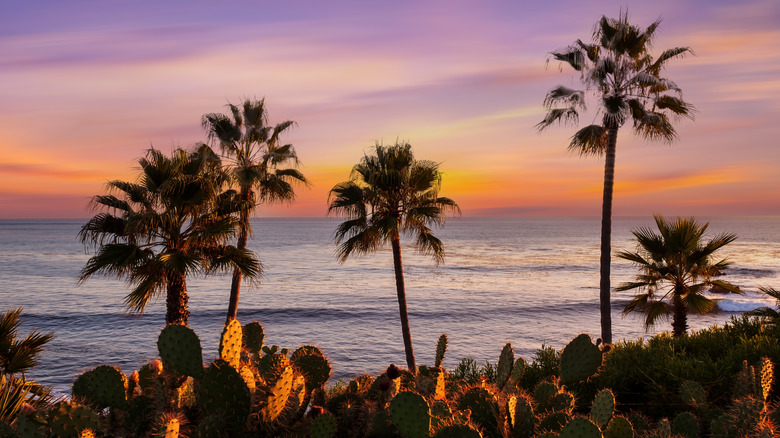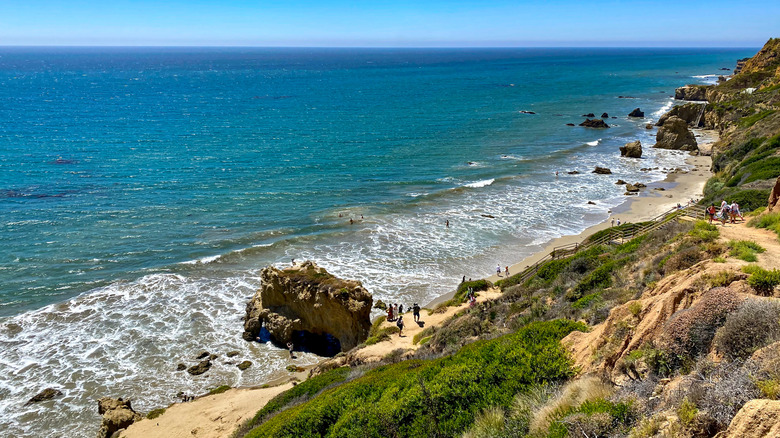The Reasons An East Coast Beach Day Will Look And Feel Very Different From A West Coast Beach Day
Everyone knows there are massive differences between the East Coast and West Coast in terms of countless factors, like culture, history, geography, demographics, weather, and architecture. It also might be tempting to think that one of the aspects both coasts have in common is their beaches — after all, because most beaches are comprised of a large body of water flowing across an extended patch of sand, can Myrtle Beach really be that different than Malibu?
Actually, yes. As any seasoned traveler of the U.S. will tell you, spending a day at an East Coast beach can be quite a different experience from a day at a typical West Coast paradise. Some of these distinctions are due to the social differences between the populations; folks on the East Coast tend to live faster-paced lifestyles, while folks on the West Coast tend to take life a little slower. These attitudes greatly affect how beaches on each coast are developed and maintained, resulting in the deviations. There are also quite a few natural and environmental factors that impact the way beaches look and feel. Weather, climate, wildlife, and geography play massive roles in the accessibility and allure of a beach, far more than we might realize.
Different climate patterns
East Coast beaches have climate patterns that are quite different from those of beaches found on the West Coast. This largely concerns ocean temperature. The Pacific Ocean is considerably cooler than the Atlantic, even when both coastal regions have the same temperature on land. Warmer waters that flow towards the West Coast are pushed west and south away from the land, which brings up the colder water beneath the surface. In fact, this causes California's waters to differ from others in an unpleasant way. Meanwhile, the East Coast is subject to much warmer waters brought up from the Caribbean, resulting in noticeably hotter swimming conditions. In fact, there's as much as a 15-degree Fahrenheit difference between the two coasts during the summer months.
Even though both coasts can get comparably hot in their respective summers, their atmospheric conditions can differ a fair amount. For example, East Coast beaches tend to be far more humid, and this is because the same currents that bring warm water from the Caribbean also bring additional moisture. However, because West Coast beaches get their water from colder sources, this results in an overall drier climate.
When it comes to weather, East Coast beaches experience far more variability, with summers getting fairly hot and winters getting fairly cold, so a day at the beach can change depending on which season you're visiting. However, West Coast beaches tend to experience milder weather year-round, with rare extremes in either direction. But it should be noted that beaches in Florida, Georgia, and South Carolina have weather that's pretty comparable to much of the West Coast.
Different beach cultures
There's some truth to the laid-back hippie stereotype that pervades the West Coast. Surfing is big there, especially in California, which should come as a surprise to absolutely no one. Also, the West Coast is typified by a more relaxed attitude, so you can expect the people of beach towns and cities to live life at a slower pace. Overall, people go to West Coast beaches to relax and get away from crowds on an expansive sandy shore. Contributing to this reality is the fact that there is a large number of beaches that are designated national parks, making them more attractive to adventurers and less so to massive crowds.
This is quite different from the culture prevalent on East Coast beaches. There are far more big cities and attractions, which make them tourist hotspots. You won't find nearly as many empty stretches of coastline that are preserved for their fragile ecosystems. However, you'll certainly find more resort destinations and even wharfs filled with nightclubs and restaurants along many East Coast beaches. A great example of this would be the boardwalk at Virginia Beach, the "world's longest stretch of pleasure beach," with activities, food, and beauty.
Still, there is plenty of overlap between the beaches of both coasts. People flock to both to enjoy many of the same activities, like swimming, fishing, and sunbathing. It really comes down to what kind of experience you want to have at the beach — are you going to kick back and relax or party?
Different marine life
Just like the culture and lifestyle differences between the East and West coasts, both have wildly different marine life, as well. For example, visitors are likely to see far more mammals on Pacific Beaches, such as various types of whales, dolphins, sea lions, walruses, and sea otters (and you can learn even more about these amazing creatures at this California aquarium that's regarded as one of America's best). Also, because of the colder waters of the Pacific Ocean, kelp forests are far more prevalent along West Coast beaches, which are home to a variety of fish and other underwater creatures.
The warmer waters of the Atlantic Ocean mean that the marine life of East Coast beaches differs from its western counterparts. Several types of sea turtles can be found along the East Coast, as well as crustaceans like blue crabs and American lobsters. There is also a whole plethora of fish you're more likely to encounter in East Coast waters than those of the west, like Atlantic cod, American eels, and monkfish.



